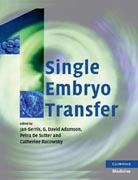
Single Embryo Transfer
Gerris, Jan
Adamson, G. David
De Sutter, Petra
Racowsky, Catherine
Multiple pregnancies are the most frequent and serious complication of assisted reproduction. Both high-order multiple and twin pregnancies entail a number of medical and economic outcomes that affect the children, the mother, the parents, the families, and society as a whole. Limiting the number of embryos to transfer is the only method available to decrease the incidence of multiple pregnancies. Single Embryo Transfer reviews the advantages and limitations of this approach to assisted reproduction. The crucial issue of selecting the best embryo will be reviewed in detail. All clinical issues involved in setting up and running an SET programme will be covered, including important topics such as cryopreservation of embryos, embryo donation, and patient counselling. The final chapters on future SET trends in Europe and North America are written by leading figures in the IVF world. The book is of interest to physicians, embryologists, nurses, insurers, politicians, ethicists and patients. INDICE: Preface Jan Gerris; Part I. Preliminaries: 1. The risks associated with multiple pregnancies Ulla-Britt Wennerholm; 2. An overview of determinants of oocyte and embryo developmental competence: specificity, accuracy and applicability in clinical IVF Jonathan Van Blerkom; Part II. Clinical Aspects: 3. Single embryo transfer - concepts and definitions Jan Gerris and Petra De Sutter; 4. Patient selection for single embryo transfer Ofer Fainaru and Mark D. Hornstein; 5. Perinatal outcome after single embryo transfer Petra De Sutter and Jan Gerris; 6. Single embryo transfer as a model for early conception and implantation Anja Pinborg and Anne Loft; 7. Ovarian stimulation, blastocyst culture and preimplantation genetic screening for elective single embryo transfer Steven J. McArthur and Robert Jansen; 8. Sequential embryo selection for single embryo transfer Lynette Scott; 9A. Cryo-augmentation after single embryo transfer: the European experience Aila Tiitinen; 9B. Cryo-augmentation after single embryo transfer: the American experience Marius Meintjes; 10A. Single embryo transfer in recipients of donated oocytes Viveca Söderström-Anttilla; 10B. The impact of single embryo transfer on embryo donation Jeffrey A. Keenan and Reginald Finger; 10C. Single embryo transfer in unique clinical situations: single women, lesbians Karen Purcell; 10D. Preimplantation genetic diagnosis and single embryo transfer Willem Verpoest; 11. Counselling patients for single embryo transfer Sharon N. Covington; 12. Stress-reduction techniques to reduce patient dropout rates during elective single embryo transfer Janetti Marotta; 13. Barriers for elective single embryo transfer implementation A. M. van Peperstraten, J. A. M. Kremer and D. D. M. Braat; 14. Single embryo transfer - the Swedish experience Christina Bergh, P. O. Karlström and Ann Thurin-Kjellberg; 15. Single embryo transfer - the Dutch experience Aafke P. A. van Montfoort; 16. Philosophical and ethical considerations on single embryo transfer Guido Pennings; Part III. Controversies: 17. What is the optimum day of transfer for single embryo transfer? Success rates, monozygotic twinning and epigenetic issues Christine C. Skiadas and Catherine Racowsky; 18. Cost-effectiveness of single embryo transfer in assisted reproduction cycles John Collins; 19. Defining success in assisted reproduction Siladitya Bhattacharya; 20. Should sperm parameters be considered in patient selection for single embryo transfer? Denny Sakkas, Hasan M. El-Fakahany and Emre Seli; 21. Does self-regulation work for implementation of single embryo transfer? G. David Adamson; 22. How should we proceed? The American experience John M. Norian, Eric D. Levens, Alan H. DeCherney and G. David Adamson; 23. How should we proceed? The European experience André Van Steirteghem; Index.
- ISBN: 978-1-107-41152-4
- Editorial: Cambridge University Press
- Encuadernacion: Rústica
- Páginas: 326
- Fecha Publicación: 29/11/2012
- Nº Volúmenes: 1
- Idioma: Inglés
